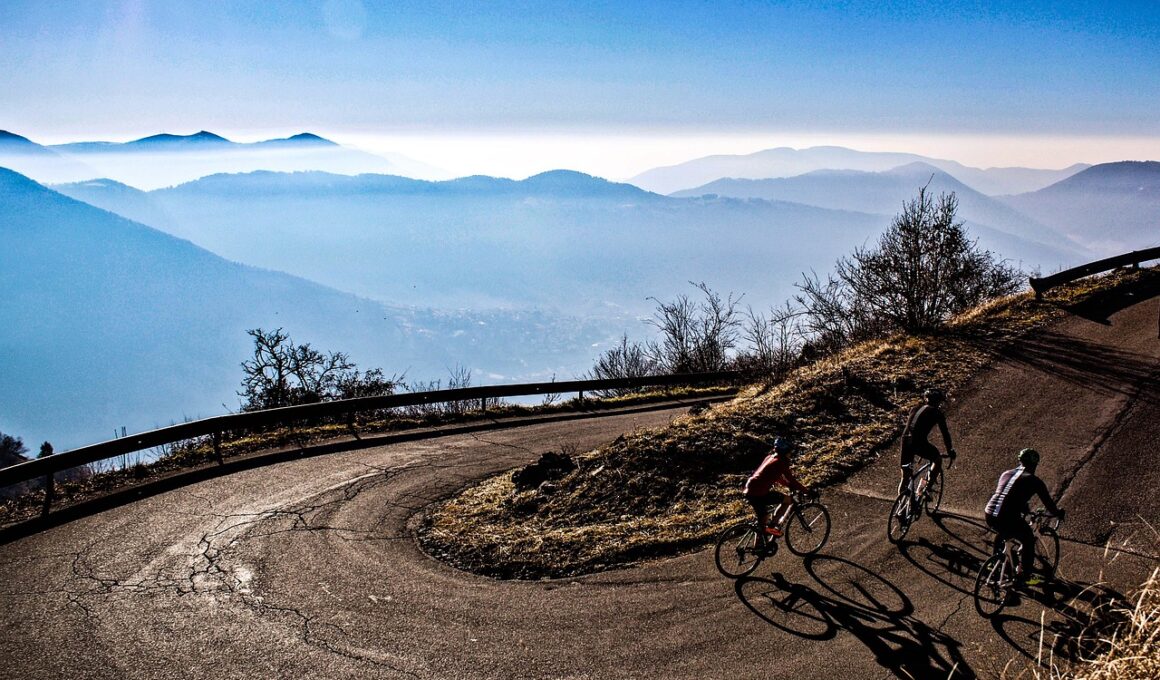Choosing Between Hardtail and Full-Suspension Mountain Bikes
When it comes to mountain biking, one of the primary decisions riders face is whether to invest in a hardtail or a full-suspension bike. Both types of mountain bikes serve distinct purposes and cater to different riding styles. Hardtail bikes typically feature a front suspension fork but lack rear suspension, making them lightweight and efficient on smooth trails. They excel in climbing steep hills and are often more affordable options. However, full-suspension bikes come with shock absorbers on both ends, providing better shock absorption over rocky or technical terrains. Riders will appreciate the additional comfort and control they offer, particularly when descending. Moreover, full-suspension bikes can help maintain traction over rugged rocks or roots. Understanding the key differences can empower cyclists to make more informed choices based on their biking preferences and the terrain they frequent. The price point of each bike type can also significantly influence a cyclist’s decision as it can sometimes dictate which features are available. Ultimately, the choice will depend on one’s riding style, preferences, and budget.
Evaluating Your Riding Style
Before choosing between hardtail and full-suspension mountain bikes, it’s vital to evaluate your riding style. If you mainly ride on cross-country trails and prefer climbing, a hardtail could be the right fit. Hardtails are typically lighter, making them faster uphill and easier to maintain compared to full-suspension bikes. While they may offer less comfort over rough terrain, they provide a more direct connection to the trail, which many riders enjoy. However, if your passion lies in tackling technical trails with significant downhill sections, a full-suspension mountain bike could be a better choice. The dual suspension system allows for a smoother ride, enhancing traction and comfort on rocky paths. Understanding how you ride—whether you prioritize speed and efficiency or comfort and control—can guide you in making the best selection. A bike suited to your riding style ultimately enhances your overall experience. Different riders value various aspects of biking, which underscores the importance of testing both options before settling on a final choice. Ultimately, determining which bike matches your riding style ensures a more enjoyable mountain biking experience.
Another factor to consider is the type of trails you will be riding most frequently. Hardtail bikes excel on smoother terrain, where the absence of rear suspension does not hinder performance. Riders navigating less technical paths will find that hardtails enable them to maintain speed and transfer power efficiently. Additionally, because hardtails are lighter than their full-suspension counterparts, handling and maneuverability on easier trails become easier and more enjoyable. However, if your trails involve drops, jumps, or other obstacles, a full-suspension bike is a better investment. The added suspension not only absorbs shocks but also offers a more versatile riding experience. With better traction and control, full-suspension bikes provide stability over rough terrain. Riders will notice the difference in comfort during long rides as well; they are less fatigued after a day on the mountain. Ultimately, aligning your bike choice with your riding environment is essential for a satisfying cycling experience. Gaining familiarity with both options can clarify which bike best suits your preferences and the kind of trails you enjoy the most.
Budget Considerations
Cost is a significant consideration when choosing between hardtail and full-suspension mountain bikes. Hardtails generally come with a lower price point compared to their full-suspension siblings, making them appealing for budget-conscious cyclists. Even entry-level hardtail bikes often come equipped with quality components, providing a good riding experience without breaking the bank. On the other hand, full-suspension bikes tend to be pricier due to the complexity of their design. The engineering required for the dual suspension complicates the manufacturing process, often leading to higher costs. However, investing in a full-suspension bike can pay off in ride quality and comfort, especially for those who ride more aggressively. Keep in mind that the long-term value of a bike may outweigh its initial cost; higher-quality components can lead to less frequent repairs and replacements. Additionally, many cyclists find that a good full-suspension bike enhances their mountain biking experience enough to justify the extra expense. Regardless of choice, ensuring you allocate a reasonable budget for maintenance is also crucial for preserving its lifespan and performance in the long run.
Another important factor in your selection process relates to the weight and durability of the bike. Hardtail mountain bikes are often made from lightweight materials, making them easier to transport and handle in a variety of situations. This lighter weight is especially beneficial for enthusiastic riders who prioritize speed and efficiency. However, the absence of rear suspension can affect how a hardtail frames up over time, especially when navigating rough terrain. In contrast, full-suspension bikes typically consist of more robust materials designed to endure the trials associated with aggressive riding. The dual-suspension system prevents accumulated stress on certain components, thus extending their longevity. Additionally, riders who tackle challenging trails frequently will appreciate the performance benefits of full-suspension designs. Understand that while weight affects climbing and speed, durability often takes precedence for more technical rides. Evaluating the types of trails you plan to conquer while considering how much ruggedness you want your bike to endure can guide your choice. Ultimately, balancing weight and durability plays a vital role when selecting your mountain bike setup.
Test Riding and Finalizing Your Choice
Once you have done your research, the final step before making a decision is to test ride both types of bikes. Visiting local bike shops can afford you the opportunity to try different models and sizes, providing a more tangible experience. Additionally, many shops allow for longer test rides, giving you a feel for how each bike handles on your preferred trails. Pay attention to how the bike feels during climbs and descents, as well as its overall comfort on longer rides. Getting a firsthand impression of the bike’s performance can aid in narrowing down your options. Moreover, seek advice from experienced mountain bikers about their preferences, as personal recommendations can offer valuable insights. Bike communities often have forums where riders share their experiences about different models. Finally, remember to consider accessories such as helmets, gloves, and pads for protective measures when you finally make your purchase. Creating a well-rounded setup that includes safety gear will further enhance your enjoyment while riding your new mountain bike.
In conclusion, choosing between hardtail and full-suspension mountain bikes involves multiple considerations that encompass your riding style, the terrain you frequent, and your budget. Both bike types have their distinct advantages and disadvantages. Hardtails, with their simplicity and weight advantage, may be better suited for cross-country riders seeking efficiency and lower costs. Conversely, full-suspension bikes appeal to those tackling Technical trails, as they offer better shock absorption and improved comfort. As you evaluate your options, understanding your priorities, testing both types, and seeking expert opinions will significantly guide your decision. Cycling should provide excitement and satisfaction, and the right bike will enhance that experience. Don’t rush the decision-making process; take your time to thoroughly consider your needs. Whether you choose a hardtail or full suspension, ensure it aligns with your personal preferences and riding objectives. Once you find the ideal bike, you’ll be equipped to enjoy countless thrilling adventures in the great outdoors. With satisfaction in your choice, the world of mountain biking awaits you.


